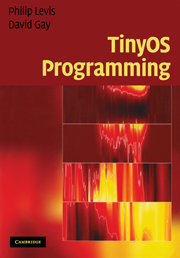1 - Introduction
Published online by Cambridge University Press: 05 August 2012
Summary
This book is about writing TinyOS systems and applications in the nesC language. This chapter gives a brief overview of TinyOS and its intended uses. TinyOS is an open-source project which a large number of research universities and companies contribute to. The main TinyOS website, www.tinyos.net, has instructions for downloading and installing the TinyOS programming environment. The website has a great deal of useful information which this book doesn't cover, such as common hardware platforms and how to install code on a node.
Networked, embedded sensors
TinyOS is designed to run on small, wireless sensors. Networks of these sensors have the potential to revolutionize a wide range of disciplines, fields, and technologies. Recent example uses of these devices include:
Golden Gate Bridge safety High-speed accelerometers collect synchonizedd ata on the movement of and oscillations within the structure of San Francisco's Golden Gate Bridge. This data allows the maintainers of the bridge to easily observe the structural health of the bridge in response to events such as high winds or traffic, as well as quickly assess possible damage after an earthquake [10]. Being wireless avoids the need for installing and maintaining miles of wires.
Volcanic monitoring Accelerometers and microphones observe seismic events on the Reventador and Tungurahua volcanoes in Ecuador. Nodes locally compare when they observe events to determine their location, and report aggregate data to a camp several kilometers away using a long-range wireless link. Small, wireless nodes allow geologists and geophysicists to install dense, remote scientific instruments [30], obtaining data that answers other questions about unapproachable environments.
Information
- Type
- Chapter
- Information
- TinyOS Programming , pp. 3 - 9Publisher: Cambridge University PressPrint publication year: 2009
Accessibility standard: Unknown
Why this information is here
This section outlines the accessibility features of this content - including support for screen readers, full keyboard navigation and high-contrast display options. This may not be relevant for you.Accessibility Information
- 2
- Cited by
